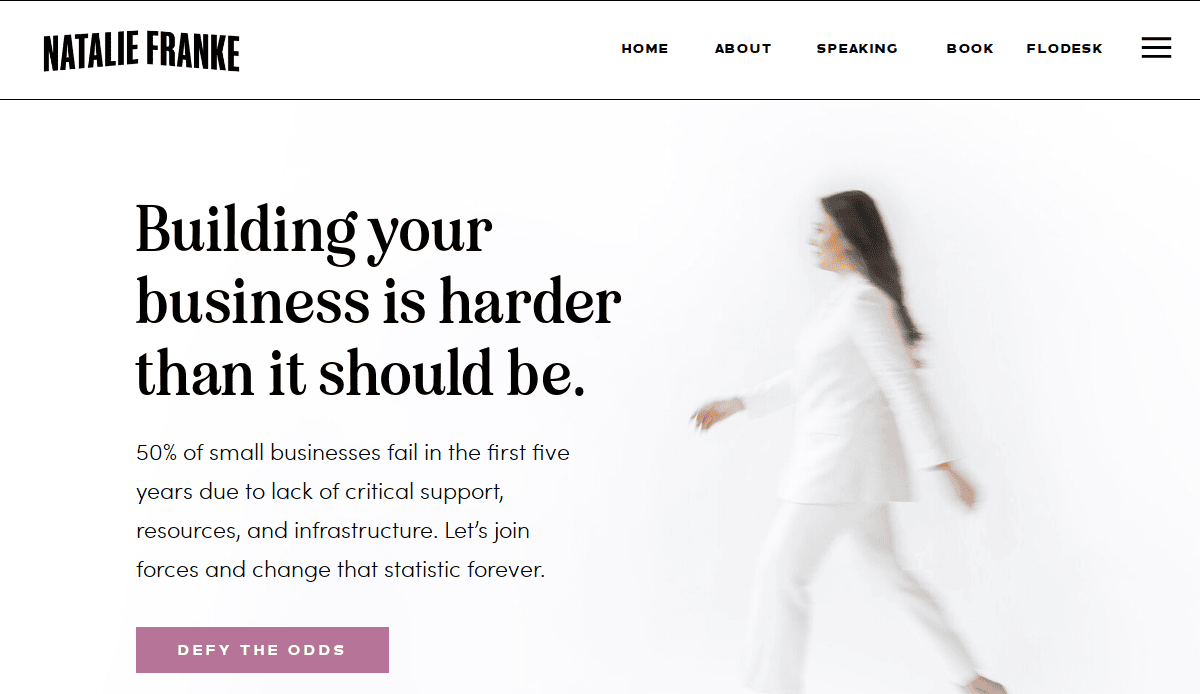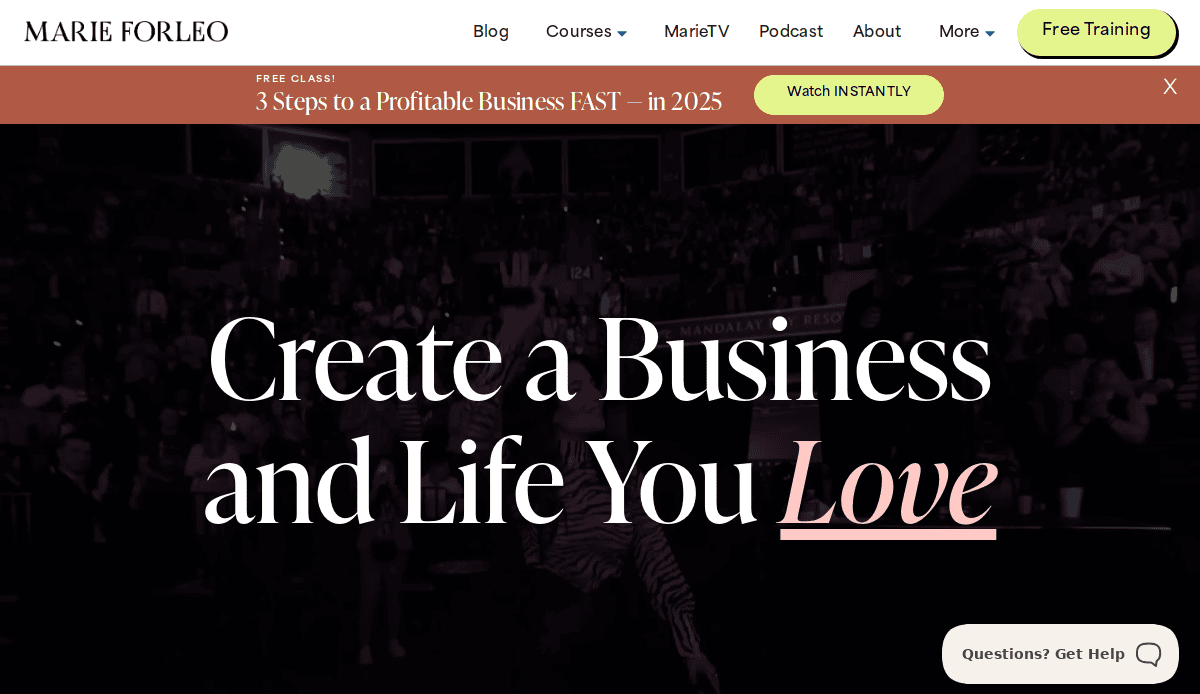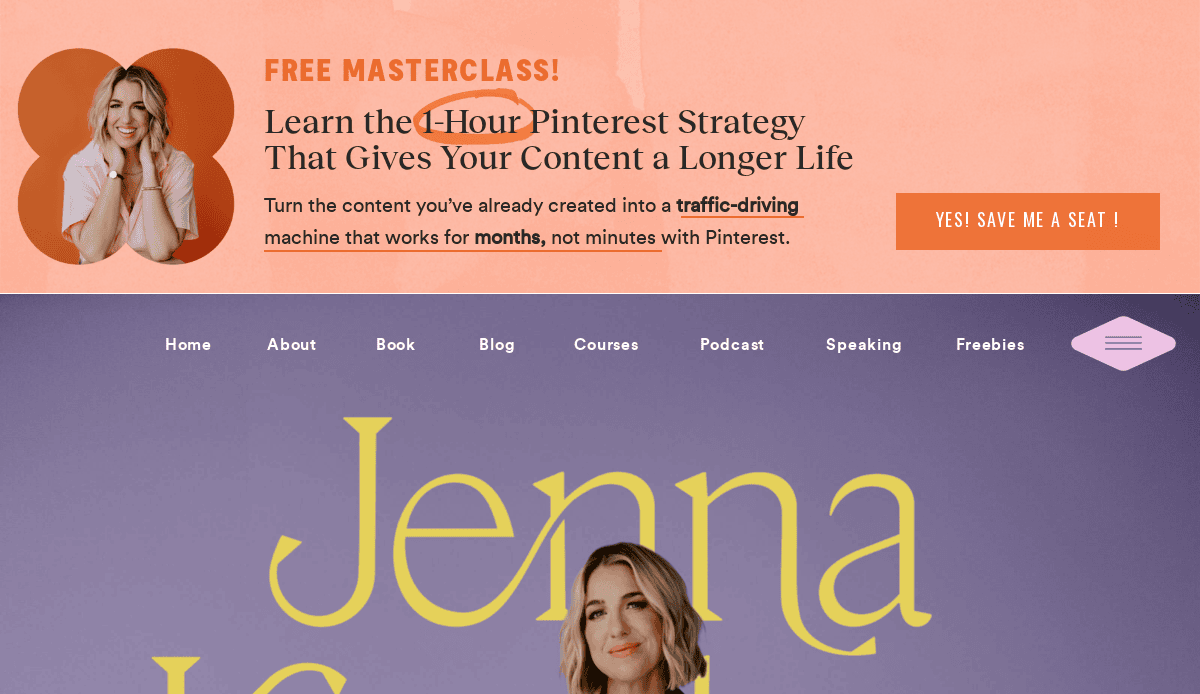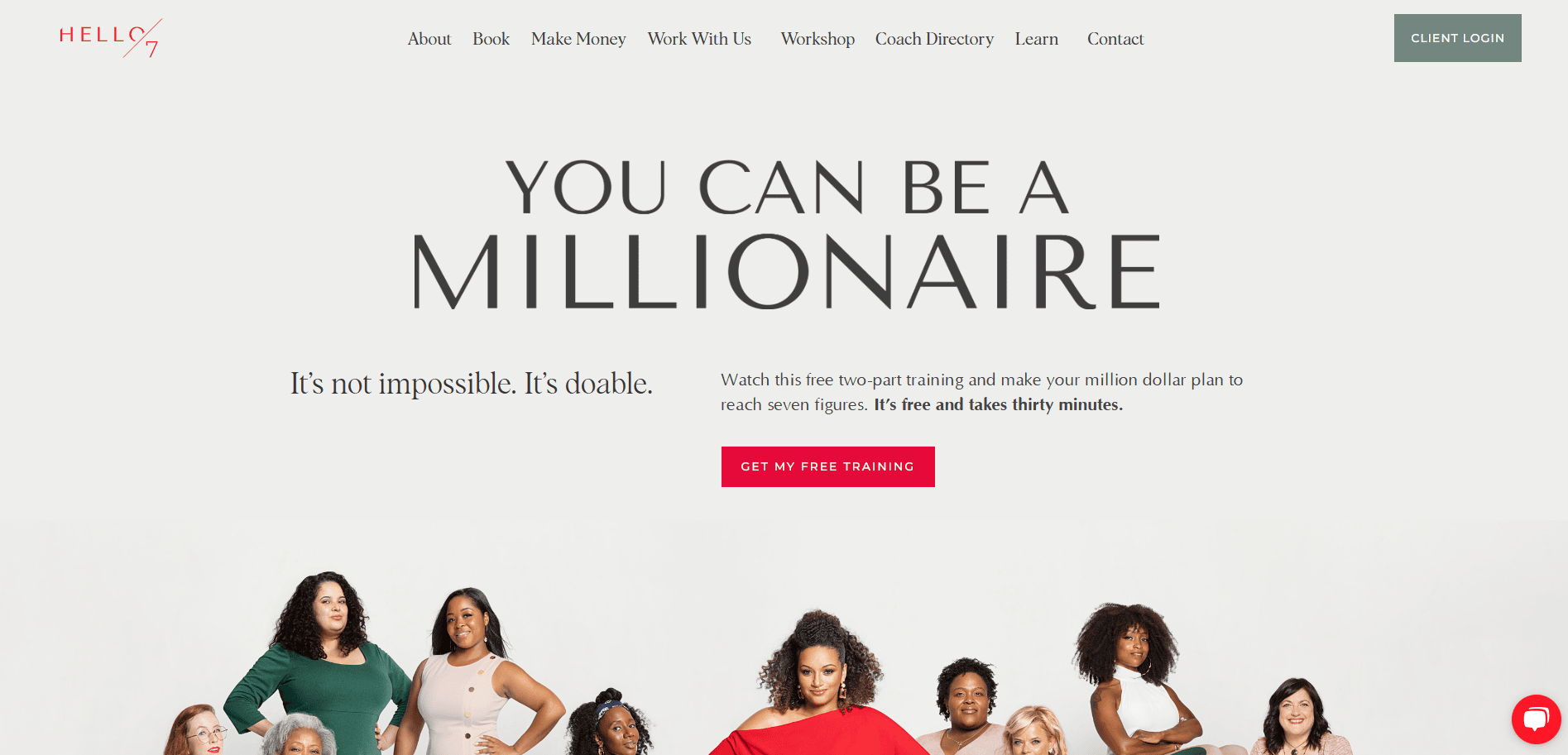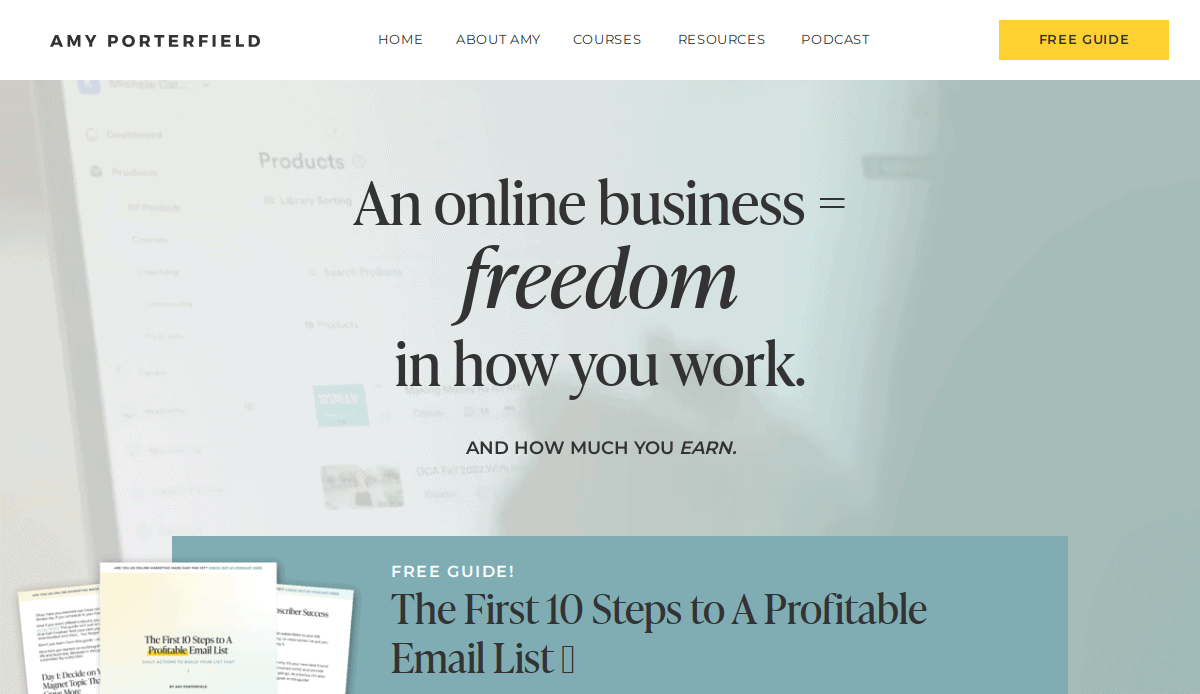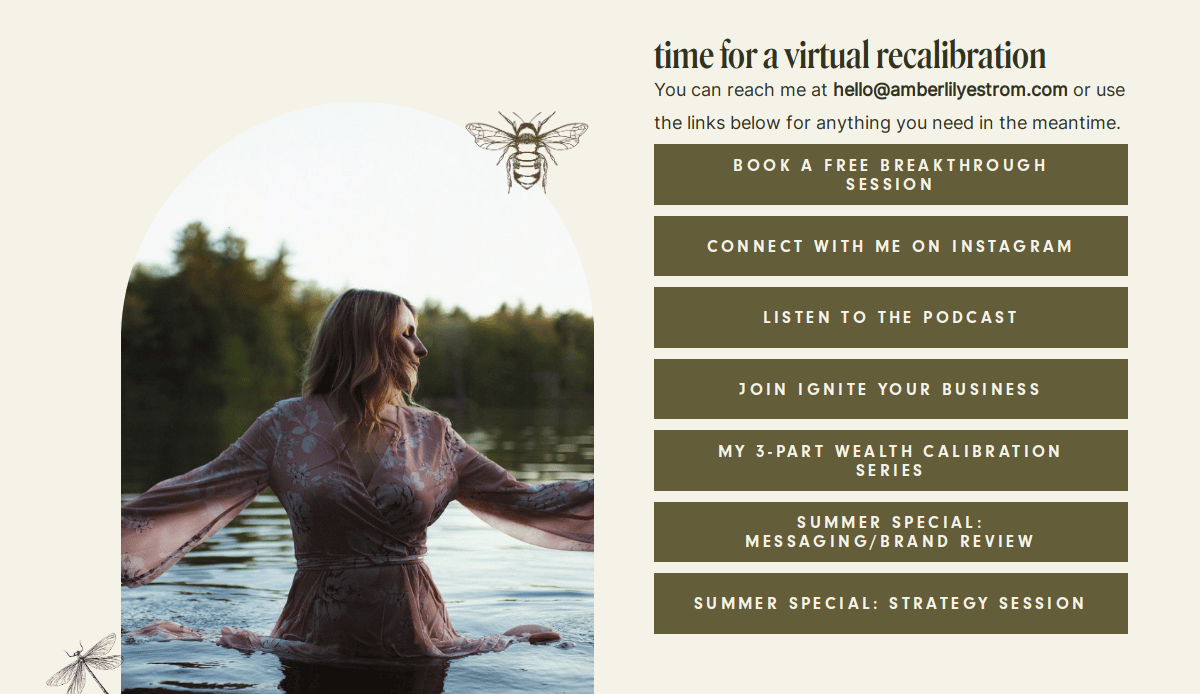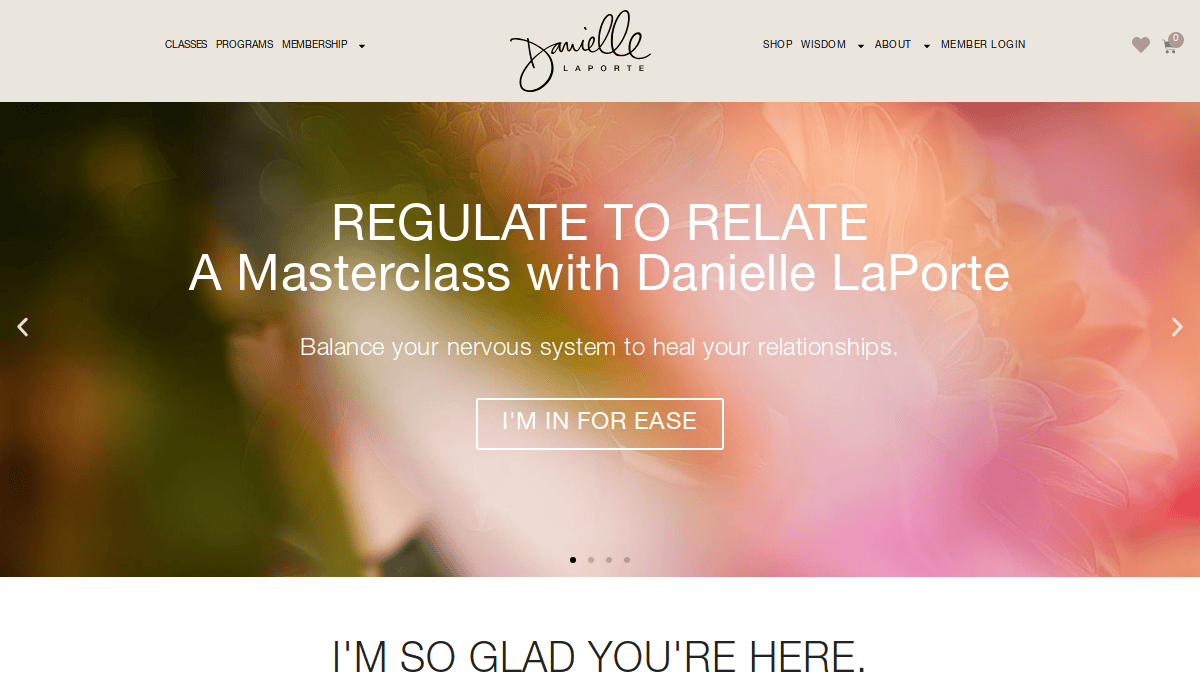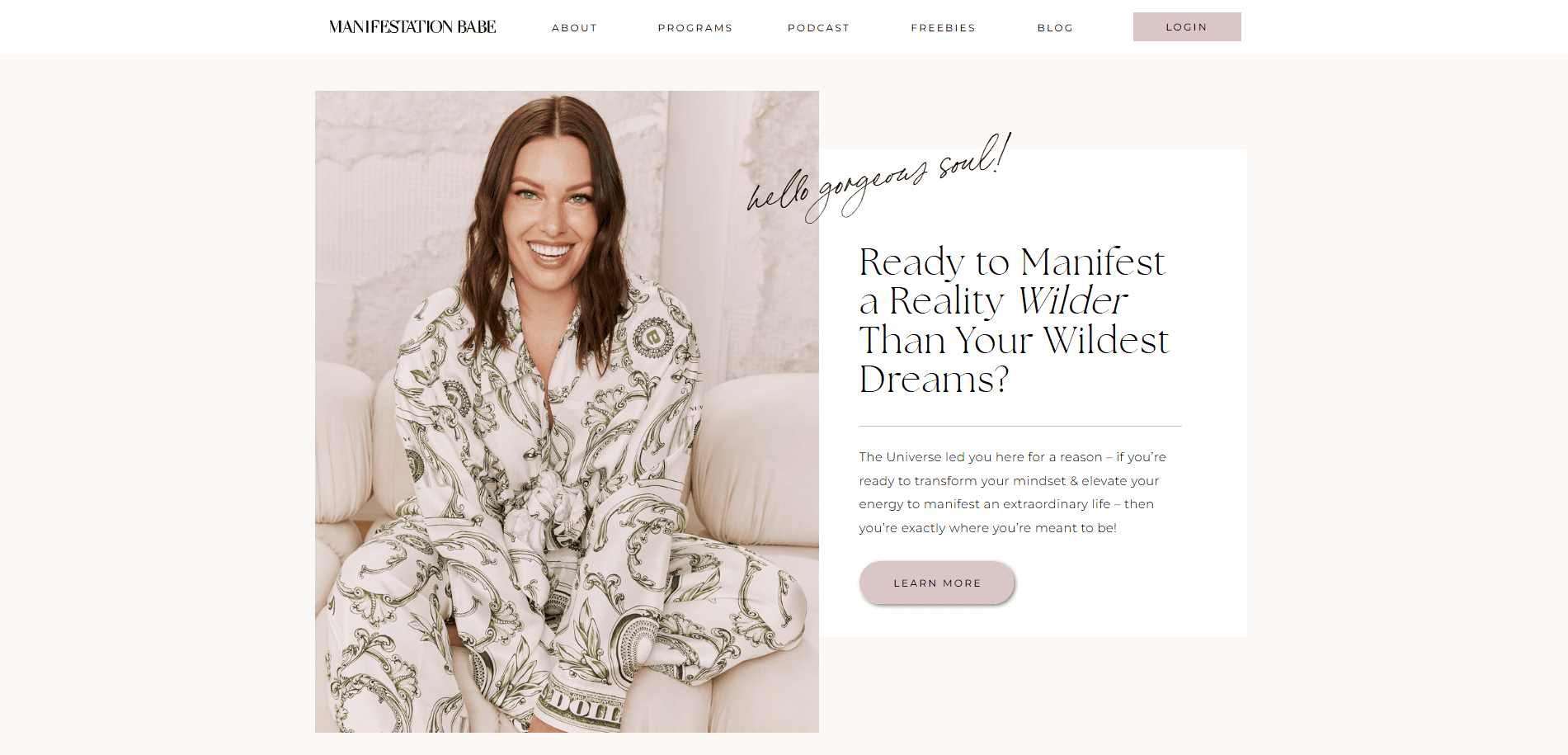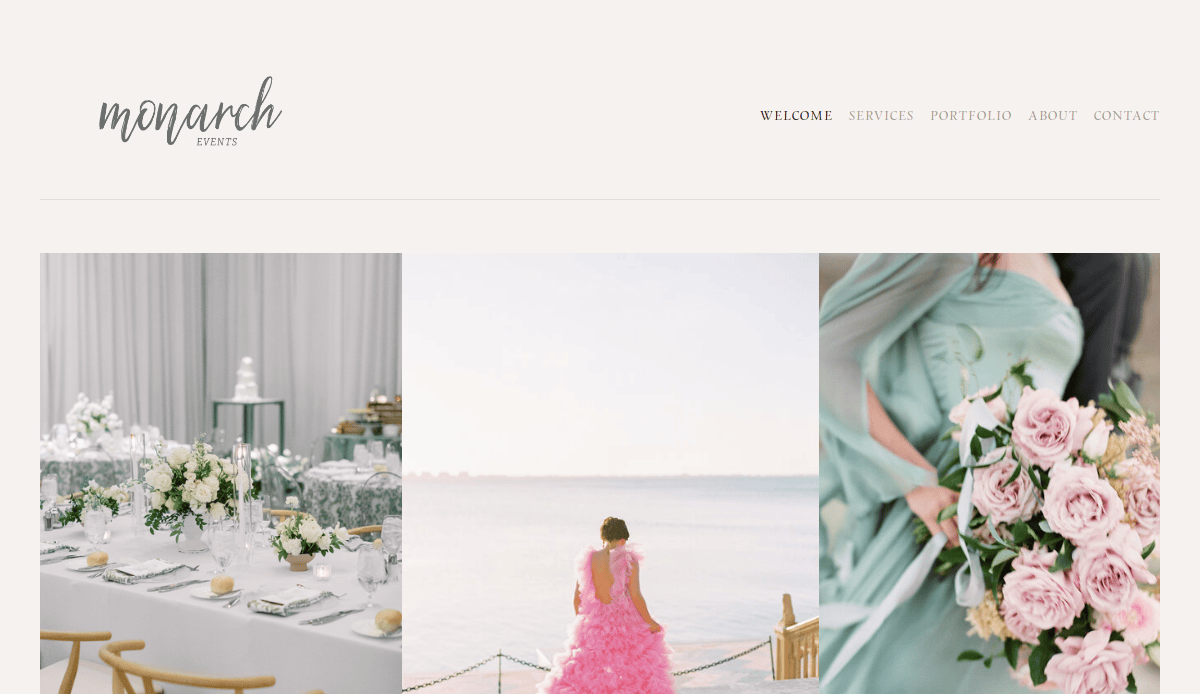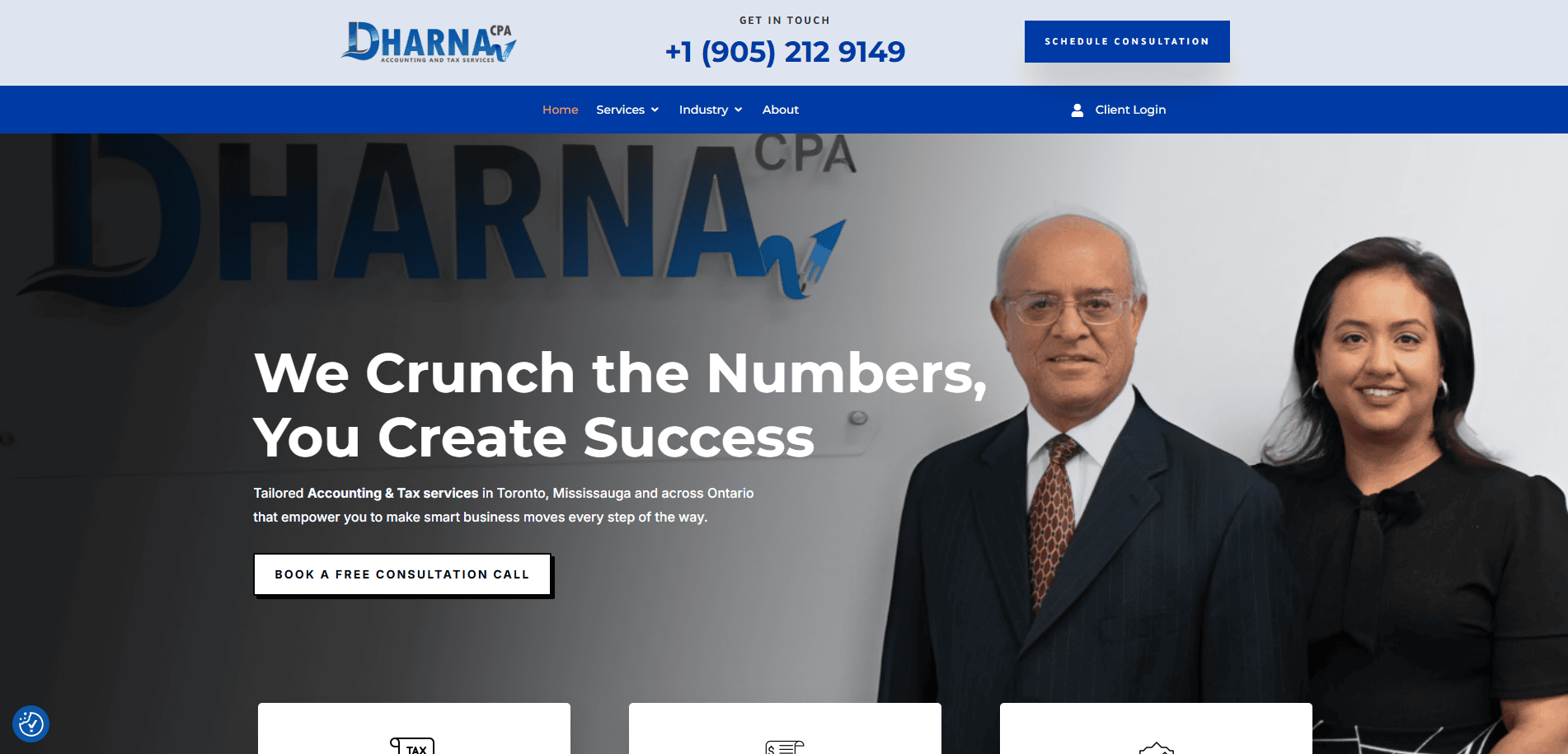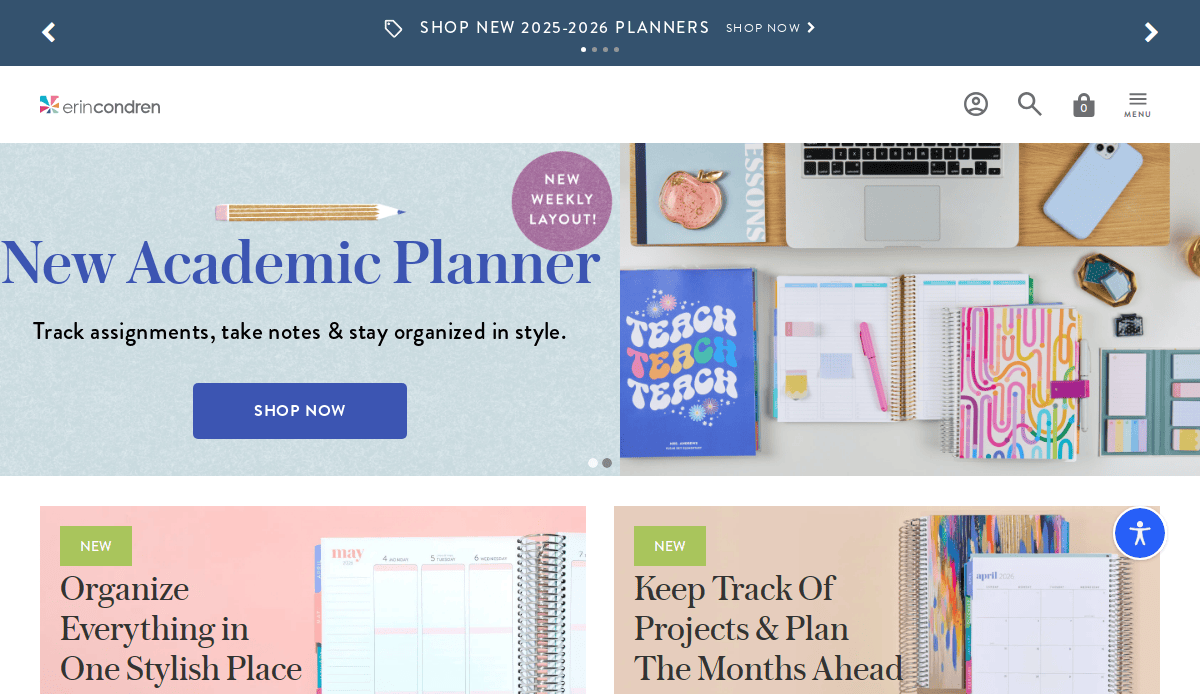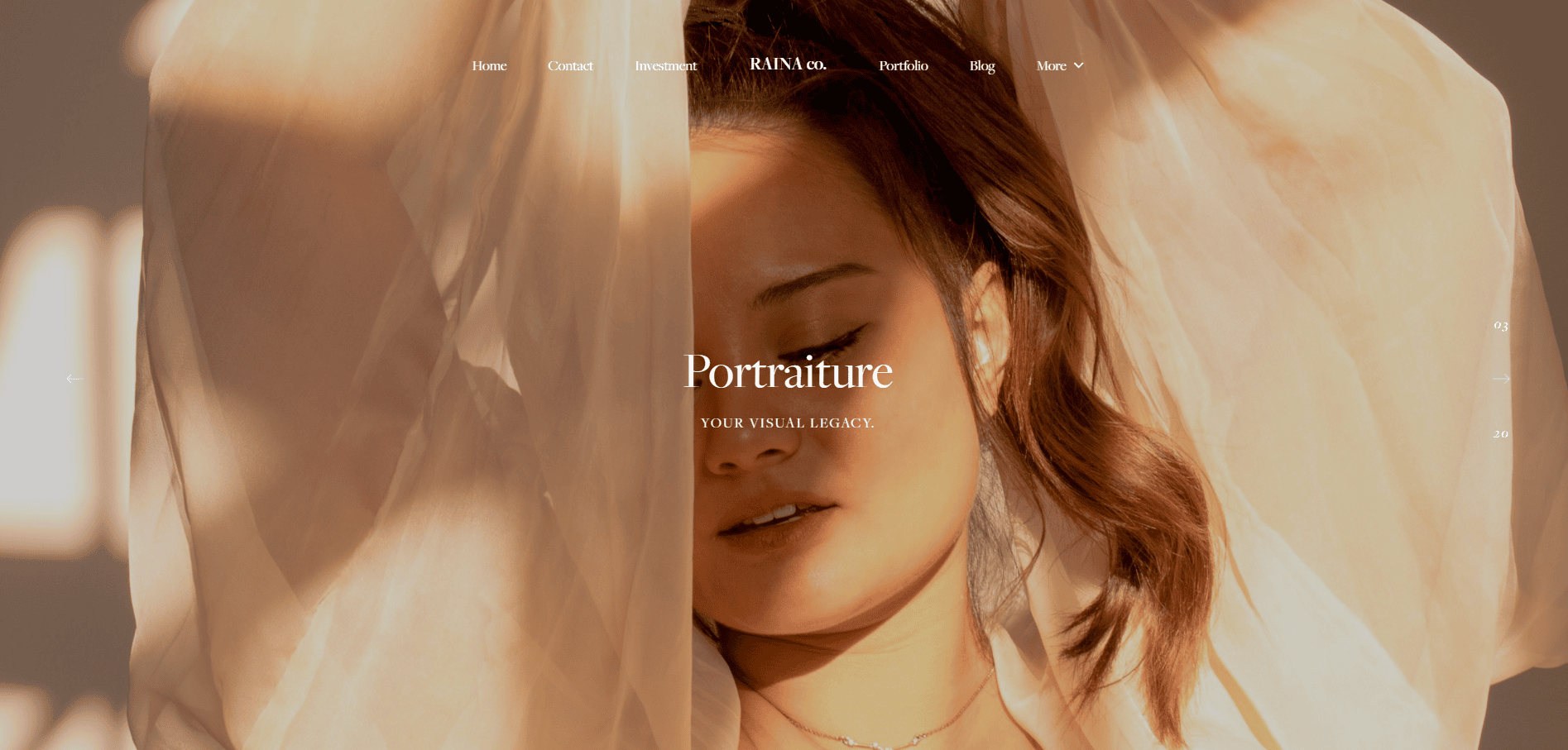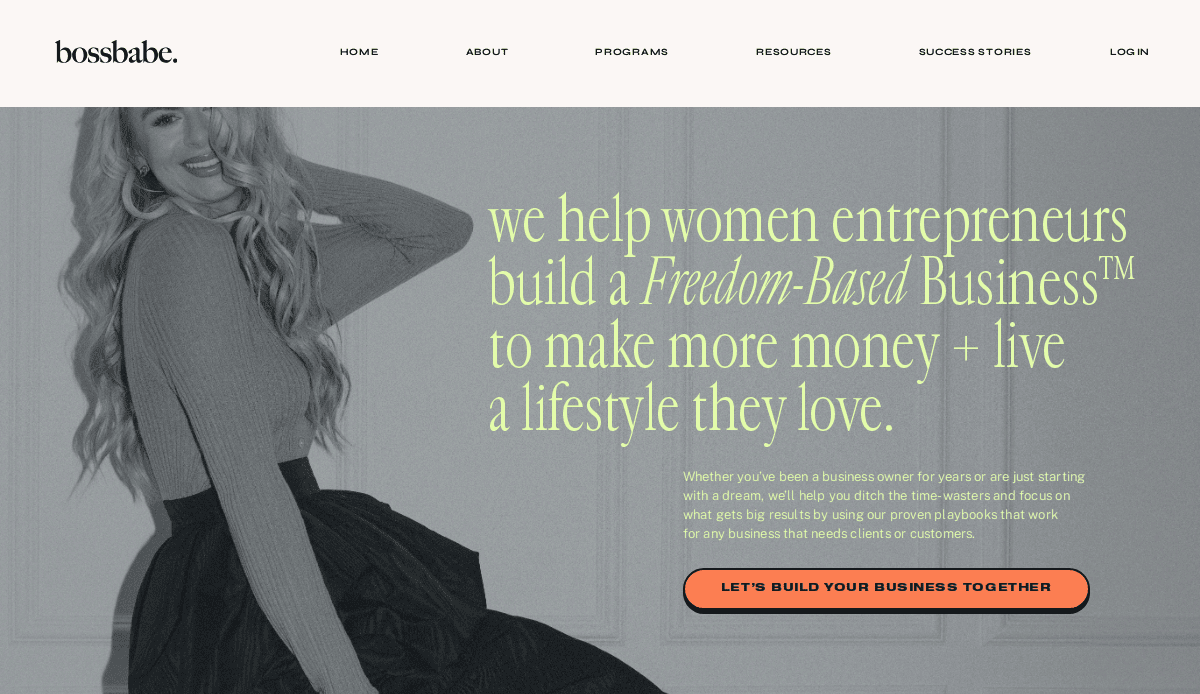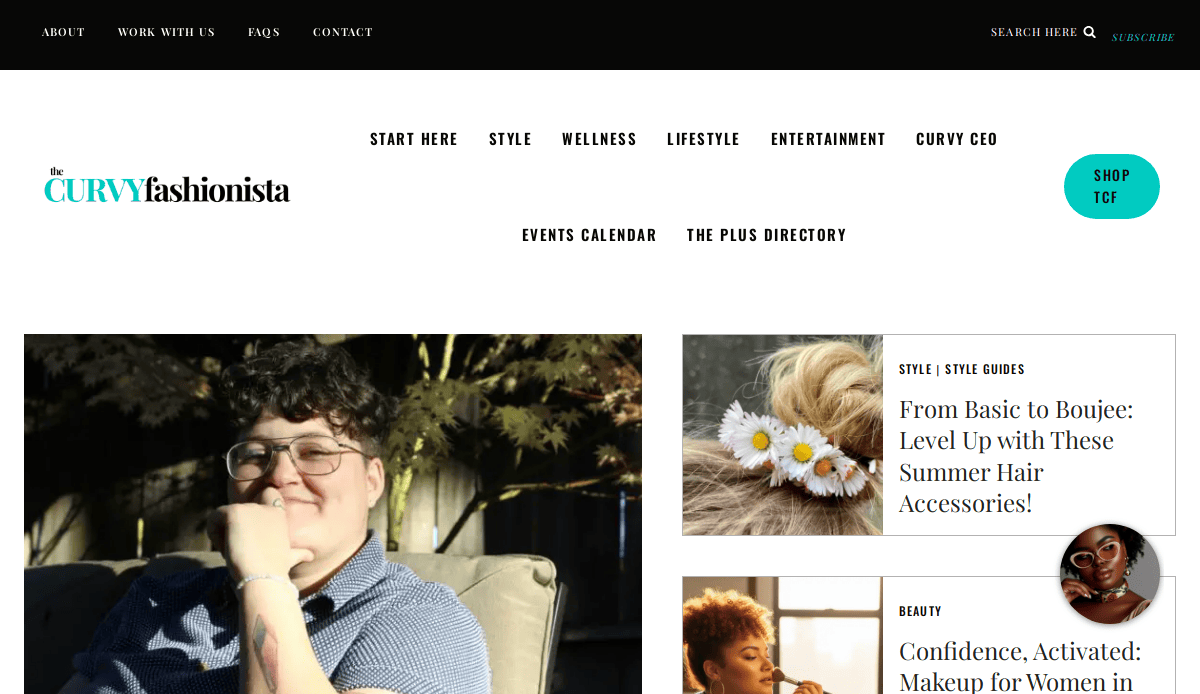Just looking for our Best Female Entrepreneur Website examples list?
Key Takeaways
- Purpose Comes First
Effective web design begins with clear business goals. Whether you’re aiming to attract clients, build authority, or drive conversions, a defined purpose ensures every design and content decision supports that objective. - Design Is Strategy, Not Just Style
Smart design principles—such as simplicity, visual hierarchy, consistent branding, and mobile responsiveness—create intuitive, conversion-ready experiences that reflect your unique brand identity. - Navigation Should Guide, Not Confuse
Streamlined navigation and a clear content structure help users find what they need quickly, increasing trust and reducing friction. Every page should serve a clear role in the user journey. - Visuals Speak Louder Than Words
Photos, typography, color palettes, and graphics should all reinforce your brand and values. Visual design influences how visitors feel about your business in the first few seconds. - Maintenance Keeps Everything Running Smoothly
Your website needs regular updates, backups, security checks, and SEO tuning to remain safe, fast, and visible. Without ongoing WordPress maintenance, even the best-designed site can falter. - Done Right, Your Website Becomes a Growth Engine
With the right planning, design, content, and support, your site becomes more than just a digital brochure—it becomes your most powerful tool for connection, conversion, and brand growth.
Why Website Design Matters for Female Entrepreneurs: A Strategic Guide
Today, a high-performing website is no longer optional—it’s essential. For the modern female entrepreneur, the right site design is more than aesthetics. It’s about crafting a platform that speaks with confidence, builds trust, and reflects the brand’s mission with authenticity. Whether you’re a business owner launching a personal brand or scaling an established service, your site design directly impacts how customers perceive you and whether they choose to work with you.
From defining a captivating brand identity to ensuring your site is easy to navigate and SEO-ready, every element plays a vital role in attracting the right audience. This guide is tailored specifically for female entrepreneurs, providing you with the strategies and inspiration to elevate your digital presence, share success stories that resonate, and turn your WordPress website into a powerful growth tool.
Website Planning & Purpose: Laying the Groundwork for Impactful Design
Before diving into fonts, color palettes, or homepage visuals, the first and most crucial step in site design is clarity of purpose. A thoughtful planning phase ensures that the website aligns with business goals, speaks directly to ideal clients, and functions as a reliable asset for growth. A well-structured plan transforms your website from a digital placeholder into a revenue-generating machine.
The planning phase begins with defining your core objectives. Are you looking to book more consultations, sell products, showcase a portfolio, or build credibility in a saturated market? Clarifying these goals will determine everything from the sitemap to the calls-to-action. For example, a consultant might need a streamlined layout with a strong personal brand presence, while a product-based business may require intuitive navigation and high-converting product pages.
Audience identification is another critical component. Successful design speaks directly to the user, using language, visuals, and functionality that resonate with their needs and behavior. For women-led businesses, this often means balancing empowerment with professionalism, building trust through relatable messaging, and a polished brand identity.
Additionally, mapping out your content needs early helps streamline the design process. What pages are essential? What messaging needs to be front and center? Will you need a blog, booking system, or email opt-in? These functional decisions should be made at the outset, not retrofitted after launch.
To dive deeper into the technical and strategic elements of this planning phase, read our step-by-step guide to the web design process. It walks through everything from discovery and wireframing to development and post-launch success—essential reading for any business owner preparing to launch or relaunch a site.
In short, a thoughtful website plan ensures your design isn’t just beautiful—it’s purposeful. And when your purpose is clear, your audience is more likely to connect, engage, and convert.
Design Principles That Drive Results for Female Entrepreneurs
Designing a website isn’t just about looking good—it’s about guiding users through a meaningful, goal-oriented experience. Effective web design is rooted in clarity, cohesion, and intentionality. Every design decision, from layout to typography, should serve a strategic purpose: to strengthen your brand, simplify user experience, and inspire action.
- Simplicity with Intent
A clutter-free layout reduces friction and enhances user engagement. Simplicity doesn’t mean plain—it means purposeful. The most impactful websites eliminate unnecessary distractions so that the visitor’s attention is directed toward key actions, whether it’s booking a discovery call or exploring your services.
- Visual Hierarchy That Guides the Eye
Design should lead users naturally from point A to point B. Strategic placement of headlines, imagery, and calls-to-action creates a visual roadmap that keeps visitors engaged. For example, a homepage might begin with a bold mission statement, flow into an introduction, and then highlight your offerings—each step reinforcing the brand’s credibility.
- Cohesive Branding
Your website is often the first impression of your brand. Colors, fonts, and imagery should reflect your brand identity and values. For female-led businesses, this might mean a balance of warmth and professionalism, empowerment and elegance. Consistency builds trust, and trust drives conversions.
- Accessibility and Readability
Readable fonts, sufficient color contrast, and responsive design aren’t optional—they’re essential. Your content should be easily digestible across devices and screen sizes. A good website makes everyone feel welcome and supported, regardless of how they access it.
- Clear Calls-to-Action (CTAs)
Every page should encourage the user to take the next logical step. That might mean scheduling a consultation, signing up for a newsletter, or exploring a product. CTAs should be visible, action-oriented, and aligned with your users’ goals.
- Conversion-Ready Structure
Effective websites guide visitors toward a single conversion goal. Whether you want them to download a lead magnet or book a service, your site’s structure should reinforce that journey. Think of every page as a piece of a larger sales funnel.
These principles aren’t exclusive to female entrepreneurs, but how you implement them should reflect the nuances of your brand and audience. For a deeper breakdown of effective web strategies, explore our insights on crafting effective B2B website designs, which include actionable tips that apply across industries, including service-based and product-driven women-led businesses.
Design done right doesn’t just look good—it performs. And when it’s built with your goals in mind, it becomes one of your most powerful tools for business growth.
Content & Navigation: Structuring Your Site for Clarity and Connection
When it comes to site design, content and navigation are essential to creating a site that feels intentional, easy to use, and aligned with your brand’s purpose. Effective websites don’t overwhelm; they guide. And that guidance starts with how your content is organized and how users move through your site.
- Build with a User-First Mindset
Start by identifying the top reasons someone would visit your site. Are they looking to learn about your services, read your story, or schedule a consultation? Prioritize these goals by placing them in your top-level navigation. Visitors should be able to get where they need to go in two clicks or fewer.
- Create a Clear Page Hierarchy
A well-structured site typically includes these core pages:
- Home – A high-level overview that introduces your value proposition, highlights key services, and directs users further into the site.
- About – Share your mission, experience, and what sets your business apart.
- Services or Products – Clearly outline what you offer, who it’s for, and how it helps.
- Portfolio or Testimonials – Use real-world examples or client feedback to build trust.
- Blog – Provide educational content that supports optimization and positions you as an expert.
- Contact – Make it easy for visitors to reach out or take the next step.
Depending on your business model, you might also include a booking page, an FAQ page, or lead magnet landing pages.
- Write with Purpose and Personality
Your content should feel like a natural extension of who you are as a business. Use clear, direct language that speaks to your audience’s pain points and aspirations. Avoid generic phrases and instead lean into authenticity. What does your audience need to hear to feel confident choosing you?
Break up your content with subheadings, bullet points, and visuals to improve readability. Every paragraph should either inform, inspire, or move the visitor closer to action.
- Optimize Navigation for Simplicity
Keep your top menu clean and focused. Avoid cluttered dropdowns or too many categories that might confuse your visitors. Consider sticky or fixed navigation so users can easily move around your site, no matter where they are. And if your site is content-heavy, a robust footer or internal search bar can improve usability.
- Plan the Content Journey
Think of your website as a guided experience. If someone lands on your homepage, where do you want them to go next? Each page should include clear next steps—buttons that direct users to schedule a consultation, read more, or view a case study. Navigation is more than menus; it’s also about creating clear content pathways.
When content and navigation are thoughtfully planned, your website becomes a confident digital presence that supports your growth. It feels seamless to visitors, and that ease translates directly into more leads, better engagement, and increased trust. For female entrepreneurs looking to build meaningful connections online, that clarity is your competitive edge.
Visual Elements: Designing for Impact and Identity
Visual design is about strategic communication. These elements play a central role in establishing brand identity, building trust, and guiding the user experience from the moment someone lands on your site. When done well, visuals don’t just complement the content—they enhance its clarity and emotional impact.
- Define a Signature Color Palette
Your color palette should reflect the mood and values of your brand. Soft, neutral tones can communicate elegance and trust, while bold, vibrant colors might signal creativity and confidence. Consistency is key—use your chosen palette across all pages, buttons, and visual accents to create a unified and recognizable presence.
- Select Fonts That Speak Your Brand Language
Typography sets the tone for your entire website. Whether you choose a modern sans-serif or a more traditional serif font, your text should be easy to read and aligned with your brand personality. Use no more than two to three complementary fonts and maintain consistency in headers, subheadings, and body copy.
- Use Photography to Humanize the Brand
People connect with people. Incorporating personal photography—whether it’s headshots, lifestyle imagery, or behind-the-scenes shots—helps create a sense of authenticity. Avoid overused stock photos that lack personality. Instead, choose images that show you in your element, interacting with clients, or representing your product or service in real-world contexts.
- Incorporate White Space to Guide Focus
White space (or negative space) is a powerful visual tool that helps break up content, increase readability, and draw attention to key areas. It creates breathing room around images and text, making your site feel open and professional rather than crowded or overwhelming.
- Use Icons and Graphics with Purpose
Icons can simplify complex ideas and improve navigation. Custom graphics can also help illustrate services, processes, or unique offerings. Make sure these elements are styled in a way that complements your overall visual brand—clean, consistent, and never distracting from the main message.
- Make it Mobile-Optimized
A visually rich desktop experience must also translate well to mobile devices. All images, buttons, and layouts should adjust seamlessly to smaller screens without compromising readability or usability. Mobile responsiveness is essential for user experience—it’s also a ranking factor for SEO.
- Align Visuals with Content Strategy
Each visual should support the goal of the page. If a section explains your client success stories, show imagery of real clients or case studies. If you’re promoting a digital product, use mockups or demo visuals. Visuals should never be filler—they should reinforce what your content is saying and keep the user engaged.
When thoughtfully applied, visual elements do more than make your website look appealing—they create a cohesive, confidence-building experience that captures attention, reflects your professionalism, and guides visitors toward action. For female entrepreneurs seeking to elevate their online presence, strategic visuals are a cornerstone of credibility and conversion.
Ongoing WordPress Maintenance: Keeping Your Site Secure, Fast, and Effective
A beautifully designed website is only the beginning. For professionals who rely on their online presence to attract clients, promote services, or sell products, ongoing maintenance is a non-negotiable part of running a successful business. Without consistent upkeep, even the most polished site can become vulnerable, slow, or outdated, hurting your credibility and bottom line.
- Security Updates Are a Priority
WordPress powers over 40% of the web, making it a frequent target for hackers and bots. Keeping your core WordPress software, themes, and plugins updated reduces the risk of security breaches that could expose client data or bring your site down. Regular updates protect both your brand reputation and your users’ trust.
- Plugin Management Ensures Stability
Plugins extend your site’s functionality, but outdated or poorly coded ones can cause conflicts, slowdowns, or even crashes. Part of ongoing maintenance includes evaluating which plugins are essential, which need updates, and which should be replaced with more efficient alternatives. Streamlining your plugin setup improves site speed and reliability.
- Regular Backups Provide Peace of Mind
Accidents happen—files can be corrupted, content can be lost, or unauthorized changes might break your layout. Scheduled backups ensure you always have a recent version of your website ready to restore. This safety net is critical for business owners who don’t have time for technical disruptions.
- Speed Optimization Keeps Visitors Engaged
Fast load times are not just a user experience perk—they’re a conversion and optimization factor. Ongoing maintenance includes optimizing images, clearing out old data, and minimizing scripts to keep your site running quickly. A slow site can cost you both search rankings and potential customers.
- Content and Design Checks Keep You Current
Your business evolves, and your website should reflect that. Regular reviews of your content and design help ensure your offerings, testimonials, and visuals are accurate and aligned with your brand. This also presents opportunities to update seasonal promotions, add new blog content, or highlight recent client wins.
- SEO Monitoring Maintains Visibility
Search engines change constantly, and so do SEO best practices. Ongoing maintenance includes tracking keyword performance, updating metadata, and fixing broken links. Keeping your site optimized helps you stay visible in search results, especially in competitive markets.
- A Reliable Partner Makes It Easier
Managing a business is already demanding—managing a website on top of that can feel overwhelming. That’s why many choose to work with a partner who handles the technical upkeep. This ensures everything runs smoothly behind the scenes, so you can stay focused on what matters most: growing your business.
Ongoing maintenance isn’t about bells and whistles—it’s about reliability. When your website is secure, fast, and up to date, it supports your goals instead of slowing them down. For professionals who treat their site as an investment, regular maintenance is what keeps that investment performing at its peak.
Best Female Entrepreneur Website Examples
Here are 20 exceptional websites tailored for female entrepreneurs, showcasing strong branding, conversion-focused design, and modern aesthetics. These examples reflect what’s possible when strategy and creativity come together. Four of which were proudly designed by our agency.
1. Natalie Franke
Location: Annapolis, MD
Key Takeaways:
- Bold brand identity built around empowerment
- Clean, accessible layout that enhances navigation
- Personal photography to foster trust and relatability
2. Marie Forleo
Location: New York, NY
Key Takeaways:
- High-converting homepage with strong CTAs
- Polished video content and lead magnets
- Consistent brand visuals throughout
3. Jenna Kutcher
Location: Duluth, MN
Key Takeaways:
- Use of storytelling to build a connection
- Vibrant brand visuals and personal tone
- Clear monetization through courses and products
4. Hello Seven – Rachel Rodger
Location: Durham, NC
Key Takeaways:
- Mission-driven messaging aimed at empowering women of color
- Bold color palette with high-impact CTAs
- Interactive content like quizzes and community features
5. Amy Porterfield
Location: Carlsbad, CA
Key Takeaways:
- Clear content hierarchy and course promotion
- Mobile-optimized layout
- Strategic lead generation throughout the site
6. Sophia Amoruso
Location: Los Angeles, CA
Key Takeaways:
- Fashion-forward, modern aesthetic
- Strong brand tone across all messaging
- Emphasis on authority with press and media features
7. Brit + Co
Location: San Francisco, CA
Key Takeaways:
- Multimedia content for varied audiences
- High-quality imagery and DIY visuals
- Accessible layout for mobile and tablet
8. Amber Lilyestrom
Location: Portsmouth, NH
Key Takeaways:
- Personal brand-driven design
- Strong emphasis on services and coaching
- Clean, feminine aesthetic with a soft color palette
9. Danielle LaPorte
Location: Vancouver, WA
Key Takeaways:
- Inspirational and values-driven content
- Elegant design with strategic whitespace
- Premium product integration with seamless UX
10. Kathrin Zenkina – Manifestation Babe
Location: Los Angeles, CA
Key Takeaways:
- Engaging branding that resonates with spiritual entrepreneurs
- Clear product funnel design
- Community-centric elements like testimonials and podcasts
11. The Monarch Events
Location: Chicago, IL
Key Takeaways:
- Sophisticated branding and event-focused visuals
- Easy navigation with a clear services layout
- Elegant design that reflects a luxury service offering
12. Dharna CPA
Location: Naperville, IL
Key Takeaways:
- Professional, approachable design tailored for finance
- Trust-building features like client reviews
- Strategic use of colors to convey confidence and calm
13. Beaute Bar
Location: Oak Brook, IL
Key Takeaways:
- Sleek, spa-inspired design with a calming aesthetic
- Simple service navigation and booking flow
- Mobile-friendly and optimized for local SEO
14. Erin Condren
Location: Austin, TX
Key Takeaways:
- Clean, colorful design that aligns with the product line and target audience
- Clear ecommerce flow with intuitive navigation and strong visuals
- Personal brand presence that strengthens the connection with customers
15. Raina & Co.
Location: Oak Park, IL
Key Takeaways:
- Bold color use reflecting the founder’s brand energy
- Strong service CTA across all pages
- Integrated Instagram feed and social media features
16. BossBabe
Location: Los Angeles, CA
Key Takeaways:
- Consistent tone across blog, podcast, and programs
- Targeted toward scaling female entrepreneurship
- Community-building and opt-ins front and center
17. Marie Denee – The Curvy Fashionista
Location: Atlanta, GA
Key Takeaways:
- Fashion-forward design for a niche audience
- High-volume blog content with clear organization
- Vibrant, inclusive visuals
18. Tori Dunlap – Her First 100K
Location: Seattle, WA
Key Takeaways:
- Financial empowerment for women via a strong copy
- Strategic lead magnets and CTA design
- Bold, mission-based branding
19. Mel Robbins
Location: Boston, MA
Key Takeaways:
- Polished and professional with media-rich pages
- Video and podcast integration
- Clear product and booking pathways
20. Alison Faulkner
Location: Salt Lake City, UT
Key Takeaways:
- Quirky, personal branding with custom visuals
- Strong voice and authenticity in content
- Creative page layouts that break the traditional mold
These websites demonstrate how thoughtful design, clear messaging, and strategic structure help female entrepreneurs build trust, convert visitors, and showcase their brands with confidence.
Ready to Create a Website That Stands Out and Converts?
Your website is more than a digital storefront—it’s your brand’s voice, your credibility builder, and your most powerful tool for converting visitors into dream clients. For those ready to elevate their online presence, a well-designed website is no longer optional. It’s the foundation of how you connect with your audience, build trust, and scale your business with clarity and confidence.
Whether you’re shifting away from a DIY website, considering alternatives to Squarespace, or currently looking for a partner with an eye for user-friendly design and strategic functionality, the right team makes all the difference. Great branding and web design should reflect who you are, what you offer, and the impact you’re here to make. That’s why your website should be tailored for your business goals—not just beautiful, but built to perform.
If you’re looking for a website that attracts potential clients and reflects your journey as a female founder, we’re here to help you make it happen.
Start your website strategy with us, and let’s create an online home that empowers your brand and drives results.
Frequently Asked Questions: Website Design for Female Entrepreneurs
1. What are the must-haves for professional websites?
A successful website should include a strong homepage message, strategic design, compelling website copy, clear calls-to-action, and a responsive, mobile-first design. Include a blog or resource section to build credibility and ensure your website supports growth. Visual storytelling—especially content that shows the person behind the brand—adds authenticity and builds connection.
2. How is web design for female entrepreneurs different from general site design?
Web design often focuses more on personal branding, storytelling, and connecting emotionally with the audience. A website designer for female entrepreneurs understands how to balance aesthetic design elements with clear business goals to attract dream clients while showcasing the mission of the female business owner.
3. Should I use a Squarespace website or hire someone for custom design?
Squarespace and other website builders can be great starting points for early-stage entrepreneurs. However, for entrepreneurs who want a tailored solution with more flexibility, SEO performance, and a design aligned with long-term growth, it’s often better to hire someone who specializes in professional design and strategic development. If you’re ready for that transition, our top-tier digital marketing agency offers custom website design solutions built to scale.
4. What platform is best for building websites for female founders?
A WordPress site is ideal for most entrepreneurs who want full control, scalability, and access to advanced functionality like e-commerce, lead capture, or blog customization. It’s also the most SEO-friendly platform when paired with the right development strategy and content support.
5. How can I write my website copy to connect with potential clients?
Start by speaking directly to your audience’s pain points and goals. Use a conversational tone that feels authentic and reflects your voice. Share success stories, clarify what makes your business unique, and focus on how you deliver solutions for female entrepreneurs.
6. Why is mobile-first design critical for websites targeting women entrepreneurs?
Women entrepreneurs and their audiences frequently use mobile devices to browse and interact. A mobile-first design ensures your content is accessible, fast, and easy to navigate on any screen, helping you convert mobile visitors into clients and strengthening your digital presence.
7. Can minimalist design still make an impact?
Absolutely. Minimalist design—when executed with purpose—keeps your website clean, fast, and focused. It helps highlight your services, encourages interaction, and eliminates distractions. It’s especially effective for professional services and creative businesses that rely on elegant, clutter-free communication.
8. What design elements attract dream clients?
Elements like clear messaging, strong visual hierarchy, eye-catching headlines, testimonials, and intuitive navigation all help attract dream clients. The design should build trust while showcasing your personality and expertise. Use strategic colors and fonts that align with your brand identity and mission.
9. How often should female entrepreneurs update their websites?
Update your website whenever you have a new service, offer, testimonial, or blog. Even small changes like a refreshed homepage image or updated FAQ can signal that your business is active and current. Routine maintenance also helps keep your website secure and functioning properly.
10. How do I ensure my website empowers women in business?
Focus your site content on the value you provide, share your journey of entrepreneurship, and highlight other women in your network. Use a tone that is confident yet approachable, and consider adding features like community resources, testimonials from other women entrepreneurs, or a blog that speaks directly to your audience’s challenges and aspirations.
Whether you’re launching your first site or refreshing your digital presence, websites should be more than functional—they should be designed to reflect your power, your purpose, and your path forward.

